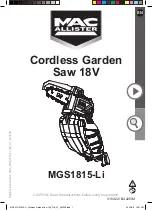
13
English
Cutting (Fig. K, L)
Place the wider portion of the saw shoe on that part of the
workpiece which is solidly supported, not on the section that
will fall off when the cut is made. As an example, Figure K
illustrates the RIGHT way to cut off the end of a board. Always
clamp work. Don’t try to hold short pieces by hand! (Figure L)
Remember to support cantilevered and overhanging
material. Use caution when sawing material from below.
Be sure saw is up to full speed before blade contacts material
to be cut. Starting saw with blade against material to be
cut or pushed forward into kerf can result in kickback. Push
the saw forward at a speed which allows the blade to cut
without laboring.
Hardness and toughness can vary even in the same piece of
material, and knotty or damp sections can put a heavy load
on the saw. When this happens, push the saw more slowly,
but hard enough to keep working without much decrease
in speed. Forcing the saw can cause rough cuts, inaccuracy,
kickback, and over‑heating of the motor.
Should your cut begin to go off the line, don’t try to force
it back on. Release the trigger switch and allow blade to
come to a complete stop. Then you can withdraw the saw,
sight anew, and start a new cut slightly inside the wrong
one. Withdraw the saw if you must shift the cut. Forcing
a correction inside the cut can stall the saw and lead
to kickback.
IF SAW STALLS, RELEASE THE TRIGGER SWITCH AND BACK THE
SAW UNTIL IT IS LOOSE. BE SURE BLADE IS STRAIGHT IN THE
CUT AND CLEAR OF THE CUTTING EDGE BEFORE RESTARTING.
As you finish a cut, release the trigger switch and allow the
blade to stop before lifting the saw from the work. As you
Workpiece Support (Fig. F, J)
WARNING:
It is important to support the work
properly and to hold the saw firmly to prevent loss of
control which could cause personal injury. Figure F
illustrates proper hand support of the saw. Maintain a
firm grip with both hands on the saw and position your
body and arm to allow you to resist kickback if it occurs.
ALWAYS TURN OFF TOOL AND REMOVE BATTERY
BEFORE MAKING ANY ADJUSTMENTS!
Figure K shows proper sawing position. Note that hands are
kept away from cutting area.
To avoid kickback
, DO support
board or panel NEAR the cut (Fig. J). DON’T support board or
panel away from the cut (Fig. J).
Place the work with its “good” side – the one on which
appearance is most important – down. The saw cuts upward,
so any splintering will be on the work face that is up when
you cut it.
Proper Hand Position (Fig. F)
WARNING:
To reduce the risk of serious personal injury,
ALWAYS
use proper hand position as shown.
WARNING:
To reduce the risk of serious personal
injury,
ALWAYS
hold securely in anticipation of a
sudden reaction.
Proper hand position requires one hand on the main
handle
20
and one hand on the auxilliary handle
11
.
Installing and Removing the Battery Pack
(Fig. E)
nOTE:
For best results, make sure your battery pack is
fully charged.
To install the battery pack
3
into the tool handle, align the
battery pack with the rails inside the tool’s handle and slide
it into the handle until the battery pack is firmly seated in the
tool and ensure that it does not disengage.
To remove the battery pack from the tool, press the release
button
12
and firmly pull the battery pack out of the tool
handle. Insert it into the charger as described in the charger
section of this manual.
OPERATION
WARNING: To reduce the risk of serious personal
injury, turn unit off and remove the battery pack
before making any adjustments or removing/
installing attachments or accessories.
An
accidental start‑up can cause injury.
Prior to Operation
• Make sure the guards have been mounted correctly. The
saw blade guard must be in closed position.
• Make sure the saw blade rotates in the direction of the
arrow on the blade.
• Do not use excessively worn saw blades.
Mounting and Adjusting the Rip Fence
(Fig. M)
Optional Accessory
The rip fence
21
is used for cutting parallel to the edge of
the workpiece.
Mounting
1. Slacken the rip fence clamp screw
22
to allow the rip
fence to pass.
2. Insert the rip fence
21
in the base plate as shown.
3. Tighten the rip fence clamp screw
22
.
Adjusting
1. Slacken the rip fence clamp screw
22
and set the rip
fence
21
to the desired width. The adjustment can be
read on the rip fence scale.
2. Tighten the rip clamp screw
22
Kerf Indicator (Fig. A)
The front of the saw shoe has a kerf indicator
9
for vertical
and bevel cutting. This indicator enables you to guide the
saw along cutting lines penciled on the material being cut.
The kerf indicator lines up with the left (inner) side of the
saw blade, which makes the slot or “kerf” cut by the moving
blade fall to the right of the indicator. Guide along the
penciled cutting line so that the kerf falls into the waste or
surplus material.
















































